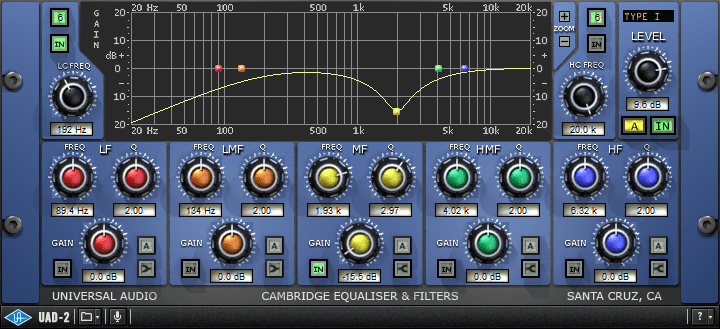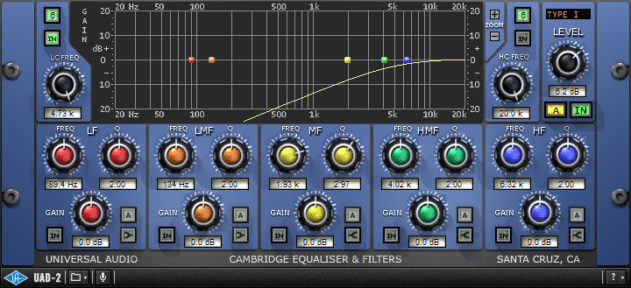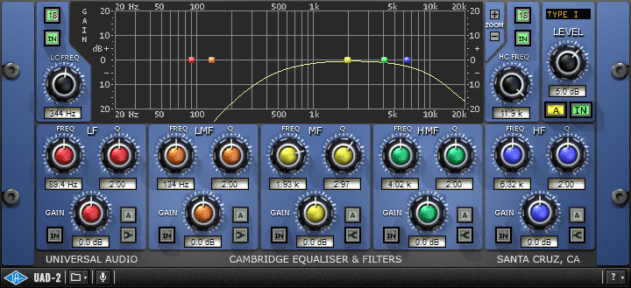Put On Your Hat
The next step is to add the hats. High frequency drum elements often sound a bit dull in isolation, but for the time being resist the urge to boost the top end. Instead, gently roll off the bottom end and slowly move the EQ frequency upwards. You may need to boost the level afterwards, but you’ll be brightening the sound overall and obeying the general EQ rule of cutting wherever possible rather than boosting.
Percussive tops loops can also benefit from a bit of topping and tailing, removing the lows and rounding off the highs. Again, resist the temptation to boost the top end of all your drum elements – you’re trying to create space within which all the elements can fit, and you still have the option of coming back later to add a subtle boost to each element, or to bus the drum parts together and apply a more subtle high-end boost to the whole sub-mix.
All Together Now
So, finally, let’s bring together all the EQd elements and see what the mix sounds like as a whole. Remember, we haven’t applied any additional reverb or compression as yet (we’ll be covering how those processes relate to mixdowns in future walkthroughs).
Here’s where we started, before any EQ processing:
And here’s how the mix sounds after we’ve applied our EQ:
It’s quite obvious that the application of EQ has increased overall clarity and made the entire mix more punchy. This should also make it easier to add additional parts and make better judgements about relative levels.
EQing in this way should be the first step of most mixdowns. Be careful not to take things too far (it’s all too easy to make your track sound sterile and over-processed if you go too far) but you’ll find that you can carve out a lot of space in your mix and clean things up dramatically using EQ alone.
/**/



05.24 PM
This is great! Thank you for all these awesome posts.
08.07 PM
Next you should do a similar process with compressors. So many new producers have no idea how to actually use one properly. The idea of using a compressor for a very specific reason seems to be amiss so often.
Anyway, awesome article!
04.47 AM
Simple , Precive, Effective.
Thanks a Lot
10.18 AM
Thanks a bunch, used the tip for eq’ing the kick on a track I just finished today and helped out loads! This site is the bees knees!
07.40 AM
Thanks! 🙂
07.44 AM
@ Gaffe: Did you read the article completly? 😀 attack magazine: “we haven’t applied any additional reverb or compression as yet (we’ll be covering how those processes relate to mixdowns in future walkthroughs).”
11.42 PM
Keep ’em coming, maybe some future garage-beats dissected/vocal eq?
12.39 AM
Great article for begginers, very good work 🙂 Please make one about EQ-ing vocals and fitting them into a track – it would be really appreciated! Cheers
12.56 AM
loading the sound demos only happens “reluctantly”. maybe a problem on my end… still worth checking though.
the content is great 🙂
04.29 PM
Excellent article, very helpful, thanks
10.38 PM
That was really really good. Thanks.
12.55 AM
Is there a rule for EQing specific sounds (like cutting the frequencies below 134 Hz for the kickdrum in the example)?
Or is it based on trial-and-error for every sound?
04.32 PM
Hey Bronco,
No rules for specific sounds I’m afraid; depends on the sound in question, on what it is doing in the mix, and on other sounds in the mix too. Most of all, it depends on what you are trying to achieve from both the sound and the mix.
There are some good practice guidelines that many producers would stand by: try to cut rather than boost; if you do boost, boost ‘wide’; and it’s often worth cutting frequencies from a sound that aren’t doing anything useful (‘topping and tailing’).
That said, in electronic music anything goes – and there are plenty of rule breakers out there making great records.
We’ll be doing more on EQ in the coming weeks. Watch this space.
Dave@Attack
06.55 PM
Thanks for your reply, Dave. It’s helpful to me =)
And keep up your great work, I’m sure that everybody who knows this website really appreciates your work.
02.35 PM
HI I have a similar question regarding EQ on Kick and Bass. Do we have to use a low latency EQ for that? and what about the Q of the lowcut should it be 6 db/oct or more? Some sites say that 6DB/Oct or even 12DB/Oct is better to use because of ringing on the cutoff slope Im on logic 9 btw what is your advice on this? I see that you use the UAD Cambridge EQ where as I like to use FabFilter Pro-Q as I don’t have UAD hardware
Thanks in advance
Best Regards,
reDJesh
12.03 AM
This is great info is well explained in an easy way to understand for people starting in music.
To me is about following all that info as a reference and also get creative,at the end the main rule is,there are no rules and the end result is what matters as far the producer can get the workflow
02.25 PM
I basically just want to hug you guys every time I read one of your excellent tutorials.
05.40 AM
Very helpful article. It’s helped me get my head round the basics. Thanks!
11.53 AM
OK, but this tutorial is useless because the bass used is played by a keyboard instead of a real bass. The drums used in these sound filesis a drum computer. Only tutorials using proper instruments are interesting
11.25 AM
Great stuff!! Thanks.
09.09 AM
If I could only get at the level of your ‘messy’ mix I would be grateful!
01.20 PM
Want to mix better and be able to pinpoint problem frequencies by heart? Try this https://www.trainyourears.com/mixlikeapro
08.28 PM
Great walk through although it would make a lot more sense to learners if a sprectrum analyzer was included for visual reference.
Cheers
03.52 PM
wow great ! i am still a baby in mixing .this one now boost my mixing up. nice one